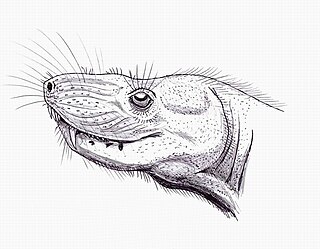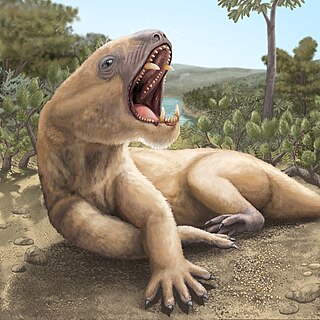
Therocephalia is an extinct suborder of eutheriodont therapsids from the Permian and Triassic. The therocephalians ("beast-heads") are named after their large skulls, which, along with the structure of their teeth, suggest that they were carnivores. Like other non-mammalian synapsids, therocephalians were once described as "mammal-like reptiles". Therocephalia is the group most closely related to the cynodonts, which gave rise to the mammals. This relationship takes evidence in a variety of skeletal features. The phylogeny of therocephalians has been disputed, as the monophyly of the group and the relationships of its members are unclear.

Eutherocephalia is an infraorder of therocephalian therapsids. Eutherocephalians are distinguished from the lycosuchids and scylacosaurids, two early therocephalian families. While lycosuchids and scyalosaurids became extinct by the end of the Permian period, eutherocephalians survived the Permian–Triassic extinction event. The group eventually became extinct in the Middle Triassic.

Moschowhaitsia is an extinct genus of therocephalian theriodonts. It was among the larger carnivores in the faunal assemblages it occurred in.
Tetracynodon is an extinct genus of therocephalian. Fossils of Tetracynodon have been found in the Karoo Basin of South Africa. Two species are known: the type species T. tenuis from the Late Permian and the species T. darti from the Early Triassic. Both species were small-bodied and probably fed on insects and small vertebrates. Although Tetracynodon is more closely related to mammals than it is to reptiles, its braincase is very primitive and shares more in common with modern amphibians and reptiles than it does with mammals.
Ictidostoma is an extinct genus of non-mammalian synapsids.

Hofmeyria is an extinct genus of therocephalians.

Microgomphodon is an extinct genus of therocephalian therapsid from the Middle Triassic of South Africa and Namibia. Currently only one species of Microgomphodon, M. oligocynus, is recognized. With fossils present in the Cynognathus Assemblage Zone (CAZ) of the Burgersdorp Formation in South Africa and Omingonde Formation of Namibia and ranging in age from late Olenekian to Anisian, it is one of the most geographically and temporally widespread therocephalian species. Moreover, its occurrence in the upper Omigonde Formation of Namibia makes Microgomphodon the latest-surviving therocephalian. Microgomphodon is a member of the family Bauriidae and a close relative of Bauria, another South African bauriid from the CAZ. Like other bauriids, it possesses several mammal-like features such as a secondary palate and broad, molar-like postcanine teeth, all of which evolved independently from mammals.
Chlynovia is an extinct genus of therocephalian therapsids from the Late Permian of Russia. The type species is C. serridentatus, named in 2000. Chlynovia was originally classified within Scaloposauria, a group of therocephalians characterized by their small size and lightly built skulls. Scaloposaurians are no longer recognized as a true grouping, but instead represent the juvenile forms of many types of therocephalians. Chlynovia was placed in the family Perplexisauridae along with Perplexisaurus, but both therocephalians are now placed in the family Ictidosuchidae.

Akidnognathidae is an extinct family of therocephalian therapsids from the Late Permian and Early Triassic of South Africa and Russia. The family includes many large-bodied therocephalians that were probably carnivorous, including Moschorhinus and Olivierosuchus. One akidnognathid, Euchambersia, may even have been venomous. Akidnognathids have robust skulls with a pair of large caniniform teeth in their upper jaws. The family is morphologically intermediate between the more basal therocephalian group Scylacosauridae and the more derived group Baurioidea.

Scylacosauria is a clade of therocephalian therapsids. It includes the basal family Scylacosauridae and the infraorder Eutherocephalia. Scylacosauridae and Eutherocephalia form this clade to the exclusion of Lycosuchidae, the most basal therocephalian family. Thus, Scylacosauria includes all therocephalians except lycosuchids. Below is a cladogram showing the phylogenetic position of Sylacosauria:

Baurioidea is a superfamily of therocephalian therapsids. It includes advanced therocephalians such as Regisaurus and Bauria. The superfamily was named by South African paleontologist Robert Broom in 1911. Bauriamorpha, named by D. M. S. Watson and Alfred Romer in 1956, is a junior synonym of Bauriodea.

Bauriidae is an extinct family of therocephalian therapsids. Bauriids were the latest-surviving group of therocephalians after the Permian–Triassic extinction event, going extinct in the Middle Triassic. They are among the most advanced eutherocephalians and possess several mammal-like features such as a secondary palate and wide postcanine teeth at the back of the jaws. Unlike other therocephalians, bauriids were herbivorous. They were also smaller than earlier members of the group. Two subfamilies are classified within Bauriidae: Nothogomphodontinae and Bauriinae.

Nanictidopidae is an extinct family of therocephalian therapsids from the Late Permian. Two genera are currently included in the family, Nanictidops from South Africa and Purlovia from Russia. Nanictidopids have short skulls and were probably herbivorous.
Blattoidealestes is an extinct genus of therocephalian therapsid from the Middle Permian of South Africa. The type species Blattoidealestes gracilis was named by South African paleontologist Lieuwe Dirk Boonstra from the Tapinocephalus Assemblage Zone in 1954. Dating back to the Middle Permian, Blattoidealestes is one of the oldest therocephalians. It is similar in appearance to the small therocephalian Perplexisaurus from Russia, and may be closely related.
Icticephalus is an extinct genus of therocephalian therapsids from the Middle and Late Permian of South Africa. The type species Icticephalus polycynodon was named from the Tapinocephalus Assemblage Zone by South African paleontologist Robert Broom in 1915. Specimens of Icticephalus have also been described from the Cistecephalus Assemblage Zone. Broom originally placed Icticephalus in the Scaloposauridae, a group of very small therocephalians. Most scaloposaurids are now thought to be juvenile forms of other therocephalians, and Scaloposauridae is no longer recognized as a valid grouping. Icticephalus and other former scaloposaurids are now classified as basal members of Baurioidea.
Ictidodon is an extinct genus of therocephalian therapsids from the Late Permian of South Africa. The type species Ictidodon agilis was named by South African paleontologist Robert Broom in 1925. Broom classified Ictidodon in the Scaloposauridae, a group of small-bodied therocephalians that are now thought to be juvenile forms of larger therocephalians. Ictidodon and many other scaloposaurids are now classified as basal members of the clade Baurioidea.
Silpholestes is an extinct genus of therocephalian therapsids from the Late Permian of South Africa. The type species Silpholestes jackae was named by South African paleontologist Robert Broom in 1948 from the Cistecephalus Assemblage Zone.
Trochosuchidae is an extinct family of therocephalian therapsids from the Permian period. It includes the genera Trochosaurus, Trochosuchus, Trochorhinus, and Hyaenasuchus. Trochosuchids are known only from the Tapinocephalus Assemblage Zone of the Beaufort Group in South Africa. Trochosuchids are basal therocephalians and are similar in appearance to another primitive group of therocephalians, the Scylacosauridae. Compared to scylacosuchids, trochosuchids have broader snouts and more flattened skulls lacking prominent sagittal crests. They have two enlarged canines on either side of the upper jaw, similar to lycosuchid therocephalians but unlike scylacosuchids, which only have one pair of canines.

Hazhenia is an extinct genus of therocephalian therapsids from the Early Triassic of China, of which Hazhenia concava is the only species. Hazhenia was named in 1981 from the Heshanggou Formation in the Ordos Desert of Inner Mongolia. It lived during the Olenekian Age of the Early Triassic, about 247 million years ago. Hazhenia belongs to a group of therocephalians called Baurioidea and possesses many mammal-like features such as cusped teeth and a secondary palate, both of which evolved independently in baurioids. Within Baurioidea it is most closely related to the genus Ordosiodon, which is also known from Inner Mongolia but comes from the slightly younger Ermaying Formation. Both genera were once placed in the family Ordosiidae, but as the name is preoccupied by a family of Cambrian trilobites, it is no longer valid.









